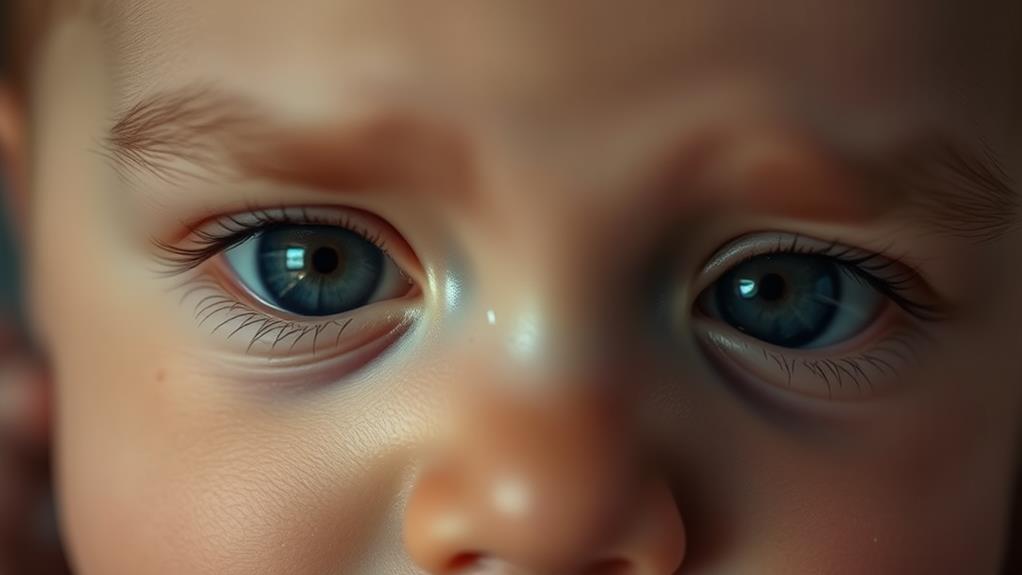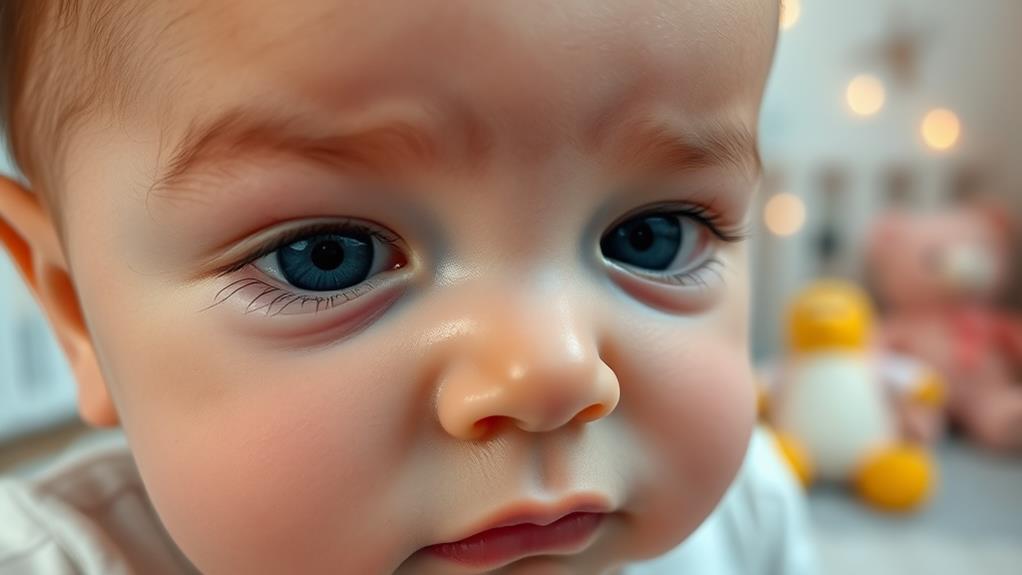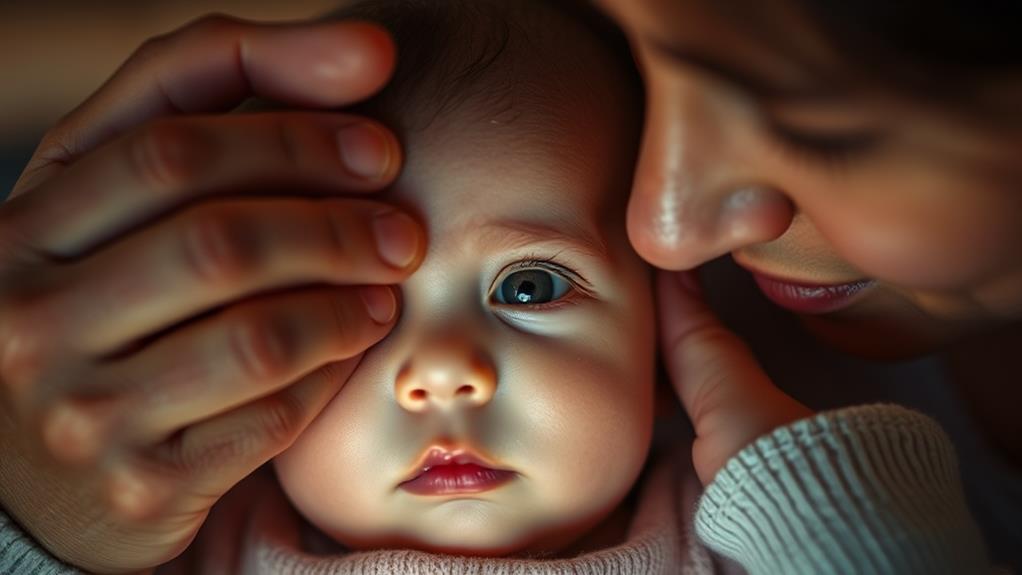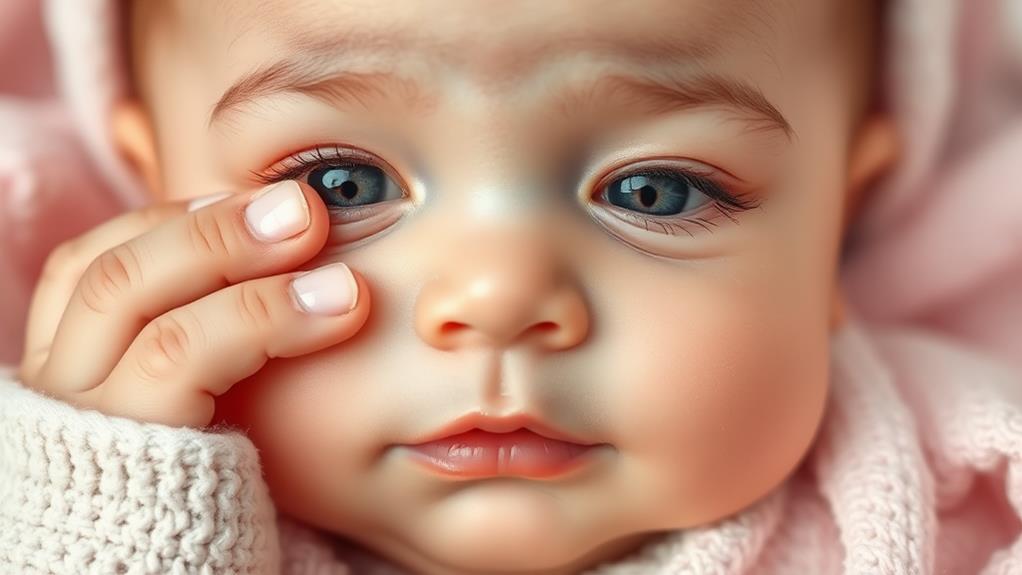If you've noticed your baby's eyes looking a bit sticky or crusty, you're not alone—many parents encounter this issue. It can stem from a range of causes, from blocked tear ducts to infections. While some cases resolve on their own, others may require your attention. You might be wondering how to differentiate between a minor concern and something that needs immediate care. Understanding the symptoms and knowing when to act can make a significant difference in your baby's comfort and health. So, what are the key signs you should be looking out for?
Understanding Sticky Eyes

Sticky eyes in babies often raise concerns for parents. You might notice that your little one's eyes seem to be glued shut with discharge, which can be alarming. Understanding this condition is the first step in addressing it effectively. Sticky eyes can occur in one or both eyes, and they may be accompanied by redness or irritation.
It's essential to remember that sticky eyes are relatively common in infants. Newborns, in particular, can face these issues as their tear ducts are still developing. You might find it helpful to know that while sticky eyes can be bothersome, they often resolve on their own.
When you observe sticky eyes, it's a good idea to check for other symptoms. Is your baby fussy or rubbing their eyes? Are there signs of swelling or fever? These clues can guide you in determining whether to seek medical advice.
Keeping your baby's eyes clean is important, so gently wiping away any discharge with a warm, damp cloth can provide comfort. By understanding sticky eyes, you're better equipped to help your baby feel more comfortable and healthy. Remember, you're not alone in this journey!
Common Causes
Several factors can lead to sticky eyes in babies, and understanding these common causes can help ease your worries.
One of the most frequent reasons for sticky eyes is a condition called blocked tear ducts. In babies, this happens when the tear ducts don't open properly, causing tears to accumulate and leading to discharge.
Another common cause is the presence of allergens, such as dust or pet dander, which can irritate your baby's eyes. If your little one has been exposed to these irritants, you might notice some stickiness.
Also, environmental factors like smoke or strong odors can contribute to the problem.
Sometimes, babies may produce excess tears due to emotions or discomfort, leading to sticky eyes. It's essential to keep an eye on any accompanying symptoms, such as redness or swelling, as they can indicate a different issue.
Lastly, your baby might simply be going through a phase where their eyes are more prone to stickiness. Keeping their eyes clean and monitoring the situation can often help.
If you're ever concerned, don't hesitate to reach out to your pediatrician for guidance.
Infections in Babies

Infections can also be a significant factor behind sticky eyes in babies. When your little one experiences a sticky discharge, it might be due to conjunctivitis, commonly known as pink eye. This condition can be caused by bacteria or viruses, leading to redness, swelling, and, of course, that gooey discharge.
If you notice your baby's eyes are crusty or sticky, it's essential to keep an eye on any other symptoms, like fever or irritability, which could indicate an infection.
Another possible infection affecting babies is a respiratory infection. Sometimes, these infections can cause excess mucus, which may drain into the eyes, creating that sticky appearance.
You might also want to keep an eye out for any signs of allergies, as they can mimic infection symptoms, although they aren't caused by germs.
If you suspect an infection, don't hesitate to consult your pediatrician. They can recommend the best course of action, whether it's eye drops or a simple cleaning routine.
Blocked Tear Ducts
Blocked tear ducts can also lead to sticky eyes in babies. When a baby's tear duct gets blocked, tears can't drain properly, causing them to pool in the eye. This situation often results in excess moisture, which can make the eyes appear sticky or even crusty.
It's a common issue, especially in newborns, and usually happens because the tear duct hasn't fully opened yet. You might notice that your baby's eyes seem watery or that they've a bit of discharge.
While it can be concerning, the good news is that many cases resolve on their own as your baby grows. In the meantime, you can help by gently wiping away any sticky buildup with a clean, damp cloth.
It's essential to be gentle and use a separate part of the cloth for each eye to prevent spreading any bacteria. If you're worried about the blockage or if it seems to persist, it's wise to consult your pediatrician.
They can offer guidance and determine if any further treatment is necessary, ensuring your little one stays comfortable and healthy. Remember, keeping an eye on these symptoms will help you know when to seek help.
Symptoms to Watch For

It's important to keep an eye out for specific symptoms that can indicate sticky eyes in your baby. One of the first signs you might notice is excessive tearing. You may see watery eyes that seem to overflow more than usual. Along with this, you could find that your baby's eyelids are stuck together, especially after naps or overnight sleep. This stickiness often comes from dried discharge or mucus.
Another symptom to watch for is redness around the eyes. If you notice your baby's eyes appearing red or inflamed, it could signal irritation or infection. You should also pay attention if your baby seems to be rubbing their eyes frequently; this could indicate discomfort.
If your little one is fussy or seems to be in pain when you touch their face, it's worth noting. In some cases, you might spot a yellow or green discharge, which can be a sign of infection.
If you observe any of these symptoms, it's essential to keep track and consult your pediatrician. Early detection can help in managing the situation effectively, ensuring your baby stays comfortable and healthy.
Treatment Options
If you notice any concerning symptoms like excessive tearing, redness, or discharge from your baby's eyes, addressing these issues promptly can help prevent further discomfort.
Start by visiting your pediatrician. They can diagnose the problem accurately and recommend the best course of action. Often, sticky eyes in babies can be caused by a blocked tear duct, which is quite common.
Your doctor might suggest massaging the area around your baby's eye gently to help open the duct. This technique can encourage drainage and alleviate symptoms. In some cases, they may recommend using a warm compress to soothe any irritation.
If an infection is suspected, your doctor might prescribe antibiotic eye drops or ointment to clear it up.
Always remember to keep your baby's eyes clean. Use a soft, damp cloth to wipe away any discharge. It's important to do this gently, as your baby's skin is sensitive.
You should also avoid touching your baby's eyes with unwashed hands to prevent introducing any bacteria. Following these treatment options can help keep your baby comfortable and promote healing, ensuring they're back to their happy self in no time.
Home Remedies

When dealing with sticky eyes in babies, there are several home remedies you can try to provide relief.
First, you can use a clean, warm washcloth to gently wipe away any discharge. Just soak the cloth in warm water, wring it out, and softly clean your baby's eyes, moving from the inner corner to the outer. This helps remove any crustiness without causing irritation.
Another option is to make a saline solution at home. Mix one teaspoon of salt in a cup of warm, distilled water. Use a clean dropper to place a few drops in your baby's affected eye. This can help flush out irritants and soothe inflammation.
You might also consider breast milk, as it contains natural antibodies. If you're breastfeeding, drop a little milk in your baby's eye for relief. Just make sure your hands are clean!
Lastly, keep your baby's environment free from allergens like dust and pet dander. Regularly washing bedding and toys can help reduce irritants.
Always monitor your baby's condition, and remember that while home remedies can provide comfort, they're not a substitute for professional medical advice.
When to Seek Help
Knowing when to seek help for sticky eyes in babies is crucial for ensuring their well-being. If you notice your baby's eyes are persistently sticky, it's time to pay attention. While some causes, like minor irritations, can be managed at home, other issues may need professional intervention.
You should seek help if your baby's sticky eyes are accompanied by symptoms such as redness, swelling, or excessive tearing. These signs could indicate an infection that requires medical treatment. Additionally, if your baby seems to be in pain, is unusually fussy, or has a fever, don't hesitate to contact your pediatrician.
It's also important to seek help if the sticky discharge doesn't improve with home remedies after a few days. Your baby's eyes are sensitive, and prolonged issues could lead to complications.
